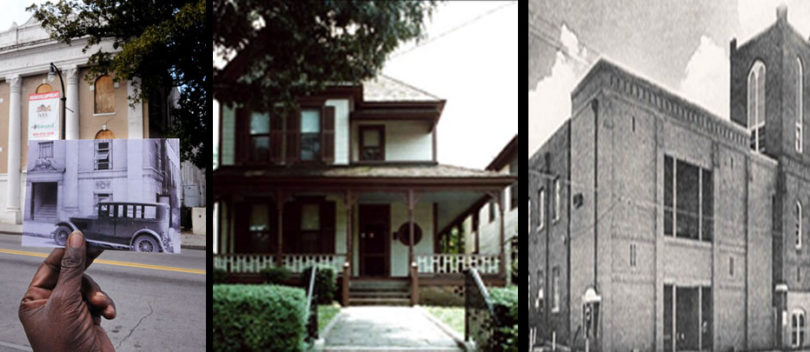The Herndon House. Paschal’s. Atlanta Life Building. These buildings and more need to be saved.
It has been 45 years since my father, J.W. Robinson Sr., an African-American architect, founded his firm in Atlanta. Growing up during a time of segregation, J.W. developed a passion for preserving our architectural and cultural history. Atlanta, a city filled with rich African-American history, became his ground zero.
Atlanta used to be a place to see and experience a variety of buildings that African Americans owned and developed for business, entertainment, worship, and housing. Now we may face a future in which our African-American landmarks are only experienced through photographs, and our architectural heritage learned about only in textbooks.
What is the state of landmarks that are owned, operated, or designed by African Americans that J.W. so passionately tried to preserve? Dire. I say that as an Atlanta native carrying on my father’s legacy as a practicing architect. The last decade has shown that most people don’t understand the significance of our historic buildings. Nor do they care about their contributions or realize how minimal the commitment is to protect our architectural and cultural history. What does this say about our city? And more importantly, how should we move forward?
The Herndon Home, a magnificent 1910 Beaux Arts mansion in Vine City, was built by African-American craftsmen and designed by Adrienne M. Herndon, with her husband Alonzo, Atlanta’s first black millionaire, acting as general contractor. Enslaved at birth, Herndon founded the Atlanta Life Insurance Company. Today their mansion sits at the edge of current and planned developments spinning around like a hurricane that has already claimed two of our notable historic symbols: the 152-year-old Friendship Baptist Church and the more-than-half-century-old Mount Vernon Baptist Church.
Just around the corner, Fountain Hall, a National Historic Landmark, crumbles in disrepair at Morris Brown College, one of the city’s oldest African-American collegiate institutions. Finished in 1882, Fountain Hall might soon fade into history due to insufficient funding or inadequate preservation.
Down the street, Paschal’s Motor Hotel, Restaurant, and La Carousel Lounge, a major African-American owned establishment where civil rights icons met to discuss and plan major issues during the Civil Rights movement, remains ravaged by time and neglect. Across town in the Martin Luther King Historic District, the futures of the Butler Street Y.M.C.A.; Prince Hall; and the original Atlanta Life Building, among others located within the area, appear to be doubtful.
But testaments to African-American history and architecture still stand tall. In Ashview Heights, Booker T. Washington High School (1924) prospers as MLK’s former school. Big Bethel A.M.E. Church (1847), one of the oldest remaining African-American religious structures in the city, restored by African-American architect John A. Lankford after a fire, endures on Sweet Auburn.
The Waluhaje Building, built and owned by African-American developer Walter H. “Chief” Aiken in 1951, served as a hotel, apartment, and entertainment facility during a time of segregation. Musicians such as Duke Ellington and Dizzy Gillespie performed in its ballroom. Thankfully, this five-story building is still in use, though it might be at risk for redevelopment in the future.
We, the city, can save these buildings. But first, the public must acknowledge that the contributions of African Americans to the design, development, and building of the “city too busy to hate” and the “Black mecca” do matter. These contributions continue to have a profound impact on the growth of Atlanta. Buildings located within the King Historic District played a vital role in Atlanta receiving funds for the Atlanta Streetcar, which is an asset to the city. More educational tours and programming for these buildings must be developed to enlighten the public about these landmarks’ significance. African-American-constructed buildings inside the King Historic District tend to receive some attention regarding the need for their historic preservation. But Atlantans should also direct their attention to buildings outside that area as well.
Most importantly, our buildings must be preserved. Residents and civic leaders should pursue a more vigorous commitment to the preservation of these landmarks. These endangered buildings require more than appreciation. They require adequate funding from the public and private sectors for repairs, improvements, and protection from demolition or major alterations.
Nearly seven decades after my father arrived in Atlanta, the city thrives as a destination for the world, one where people can visit places that were owned, designed, and built by people of African descent. The Collier Heights community in northwest Atlanta received protection when neighborhood residents successfully campaigned Atlanta Urban Design Commission to receive a historic district designation two years ago. My father designed numerous homes in the Collier Heights community.
More recently, the neighborhood was recently placed on the National Register of Historic Places. And the King Historic District flourishes as an example of how our architectural and cultural history created one of the areas most visited by national and international travelers. The district’s success started with the preservation of King’s birth home, which our firm helped to accomplish. Imagine Atlanta today without the very place where King took his first steps.
That success story can be repeated. The community — and specifically African-American architects — must be involved, have a voice, and be a part of the collective in a significant manner in future developments planned for Atlanta in both the public and private sectors.
African Americans have played and will continue to play a vital role in shaping the city’s the architectural and cultural history. Atlanta was built by people, and the buildings became what we, see, know, and experience as Atlanta. If we do not preserve our remaining African-American landmarks, a major part of Atlanta’s history will be lost. Future generations will never experience these African-American places or know their contributions that made Atlanta what it is today.
Jeffrey L. Robinson, AIA, NOMA, is a principal at J.W. Robinson and Associates, an Atlanta-based architectural firm founded by his father J.W. Robinson, FAIA, NOMA.
You can view the original article at Creative Loafing! Click the logo below.


